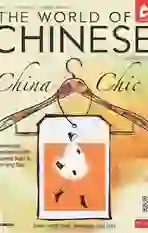DesignER CHINA
2019-04-19
Domestic designers explore national identity, balancing history with global fashion trends
It was the showstopper that launched a thousand memes, on both sides of the Pacific. But Rihannas 2015 Met Gala dress, featuring a 55-pound gold cape by haute couture designer Guo Pei, was originally considered a risky move.
Organizer Anna Wintour had reportedly feared that the years theme, “China: Through the Looking Glass,” would end up seeming racist, or like a Chinese restaurant. Instead, bemused netizens PhotoShopped pizzas, omelets, andjianbingpancakes atop Rihannas 16-foot yellow fox-fur trimmed train of Chinese floral embroidery, which took two years to make. The Washington Post, though, pronounced the evening “a thoughtful, expressive, and…utterly breathtaking exploration of China.” And state media were quick to applaud, as China Daily claimed “Chinese elements help Met attendance reach record high.”
Amid the triumphalism, there was frustration. While designers like Guo were enjoying the rare international exposure, Grace Chen, who has designed for both Oprah and Fan Bingbing, told Jing Daily that “the Western world has a huge misunderstanding of Chinese culture, and they dont even realize it.”
Chinese media are usually quick to herald any major international event featuring homegrown designers as a watershed moment. “‘Distinctly Chinese elements stealing spotlight,” crowed China Daily, again, after a “new wave of modern design that champions cultural elements from China” debuted at London Fashion Week in 2016, apparently delighting consumers “seeking Chinese-influenced design in their search for new identity and individual expression.”
The reality is more nuanced. With a history dating back millennia, as well as the aesthetics of 56 unique ethnic groups, “Chinese elements” are difficult to define. What does exist is an organic movement of young Chinese designers who are forging new markets by designing fashions that speak to their personal identity.
“When designers decide to make something ‘Chinese, some go for the most obvious thing: aqipao,” points out 32-year-old Zhang Wei, who launched her eponymous brand, Cindy Wei Zhang, in 2012, after earning a degree in fashion from Australias RMIT University. “Lets be honest, when is that last time you saw a woman wearing aqipaoto go shopping? Never, right?”
“Chinese elements can be overpowering to a design,” 33-year-old upstart designer Wang Mo stipulates. “Chinese designers can balance them because it is in our soul, but foreigners may have a difficult time.” For example, when Melania Trump visited the Great Hall of the People in 2017, the black Gucciqipao-like dress that she wore, embroidered with pink phoenixes, was criticized by some for its “cheap” fur-cuffed pink sleeves.
There is little consensus about how to balance heritage with modernity, let alone proletarian aesthetics from the 1950s and 60s that are nostalgically making a comeback. Instead, designers often rely on their personal taste. “I cannot separate myself from my brand. I am Chinese, so naturally, my clothes have a Chinese feeling,” says Wang, who came to her interview with TWOC wearing unisex clothing from her own label -A (pronounced “minus A”), which champions neutral colors, sharp tailored lines, and fine fabrics. After nine years overseas, she viewed Chinas dearth of stylistic options as a call to action: “Clothes have a special power to them. When you wear high-quality clothes that match your personal style, you look completely transformed.”
An enthusiast of traditional Chinese painting, Li Yalong moved to Tokyo to pursue his fashion studies, before returning to Beijing in 2017 and starting Yoikadakada. “I am made in China and I am proud of it,” he tells TWOC.
Li is careful, though, not to add homegrown elements for the sake of it: “When Chinese aesthetics match my design concept, I definitely use them. But, I dont rely on any single one culture for my designs. I want everyone to be able to appreciate my collections, no matter what country they are from.” (One of his most recent collections includes a purple jacket with big red Chinese characters saying “墮落天使”, Fallen Angel, on the back.)
Zhang, by contrast, actively seeks out local inspiration for her signature patterns. When starting a new collection, she visits historical sites and museums to photograph anything that she finds visually appealing, whether its the guardian figurines on the roof of the Forbidden City or Tang dynasty lacquer. For the next month or two, she produces sketches based on her favorite images until she has perfected a pattern that can be replicated on her clothes.
In 2015, Zhang worked with her grandfather, a Traditional Chinese Medicine enthusiast, to create “Herbs,” which featured patterns of sinuous greens, bulbous pinks, and cellular blues. Each garments inside tag described the medicinal effects of a plant.
“I love to wear my own clothes; I love the patterns and the colors,” Zhang says. Her designs were described by LA Fashion News as having “a purity of tone, exceptional handcrafting, and a quiet charm that has already resonated with peers.”
Designers like Zhang say they are creating clothes they always wanted to wear, but never had the opportunity to before. Using fashion to express ones individuality is a relatively new concept in China. For decades, clothes were made and patched at home with “cloth tickets” that rationed how much fabric someone could purchase.
Even after market reforms, “Chinese just had a few fashion brands to choose from, so their tastes were limited by the market options. People ended up buying the flashiest clothes they could find to show off their wealth”—a trend that persists to this day, according to Wang.
“The more independent designers like me there are, the more the sophisticated Chinese tastes will become. It means that Chinese must start reflecting about who they are and what they think is beautiful,” Wang believes. “Not only will this self-reflection benefit Chinese designers, but it will ultimately benefit Western brands, as well.” – E.C.
